INTRODUCTION
India’s agricultural sector holds immense significance, serving as the lifeblood of the nation’s economy, contributing 15.87 per cent of the Gross Value Added (GVA) and a source of livelihood for millions. The Green Revolution ushered in a period of food security for India, reducing reliance on imports and even enabling agricultural exports. However, a recent trend highlighted by Kumar and Gupta (2015) shows a significant shift in India’s agricultural sector, with farmers moving away from traditional crops towards high-value agriculture. Farmers, the stewards of our food system, are facing a dynamic environment marked by changing weather patterns, evolving consumer demands, and the need for sustainable practices. In response, a growing number of farmers are embracing innovative approaches, one of the most critical being changes in their cropping patterns. Cropping pattern refers to the plan for how crops are grown on a particular piece of land over time.
MATERIAL AND METHODS
The study was conducted following exploratory research design to assess profile of farmers involved in shift in cropping pattern in YSR district of Andhra Pradesh, was purposively selected as researcher hails
from the same region. Out of 51 mandals in YSR district six mandals were selected purposively for the study. From each of the selected mandals, two villages were selected by purposive sampling technique, thus making a total of twelve villages. From each of the selected villages, 10 farmers were selected by following simple random sampling procedure, thus making a total of 120 respondents. After a thorough review of literature and consultation with experts as set of 10 variables were selected. The data was collected through a structured interview schedule and analyzed using mean and standard deviation for drawing meaningful interpretations.
RESULTS AND DISCUSSION
The respondents were distributed into different categories based on their selected profile characteristics and the results were presented in the Table 1.
Age
It is clear that majority (62.50%) of the respondents belonged to middle age category followed by old age (20.00%) and young age (17.50%) categories respectively. The reason behind this was middle aged respondents have accumulated years of experience that allowed them to make informed decisions about planting,
Table 1. Distribution of farmers according to their profile
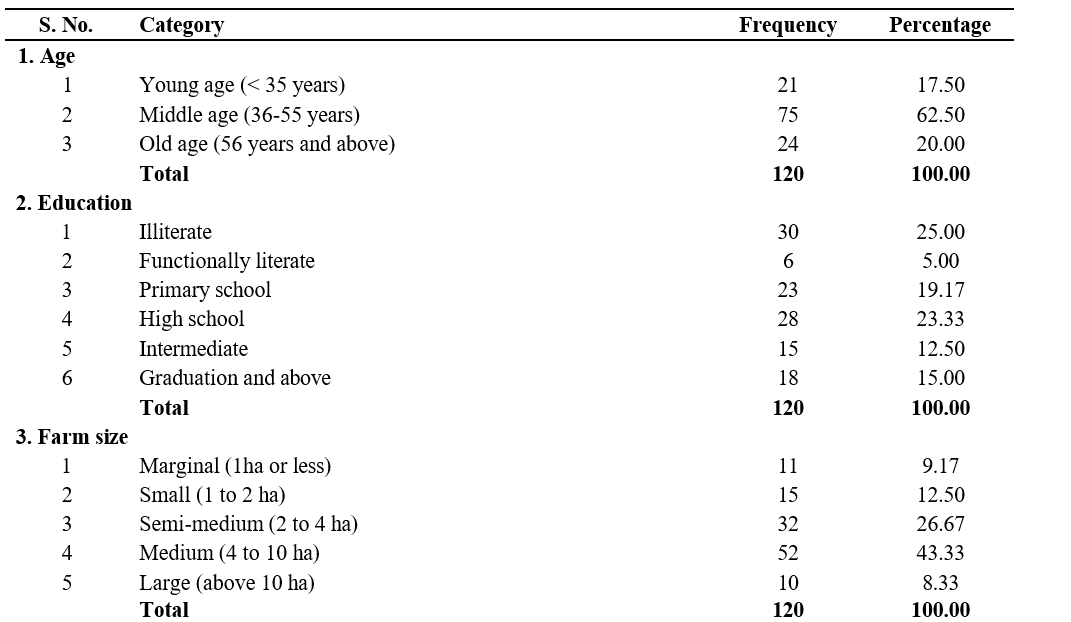
harvesting etc. This finding was in conformity with the findings of Patel (2011).
Education
One fourth (25.00%) of the respondents were illiterate followed by high school (23.33%), primary school (19.17%), graduation and above (15.00%),
intermediate (12.50%) and functionally literate (5.00%). The key reasons for this trend might be limited access to schools in rural areas, their perception is that high school education is enough for traditional farming. This finding was in conformity with the findings of Areneja et al. (2013).
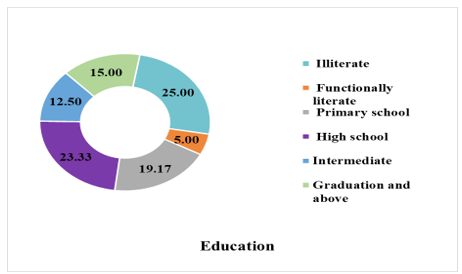
Farm size:
It is implied that a little less than half (43.33%) of the respondents had medium farm size followed by semi- medium (26.67%), small (12.50%), marginal (9.17%) and large (8.33%) farm size. This trend might be due to the fact that medium farm size offers a balance between manageability with family labour and some economics of scale for machinery and production. This finding was in accordance with the findings of Patel (2015).
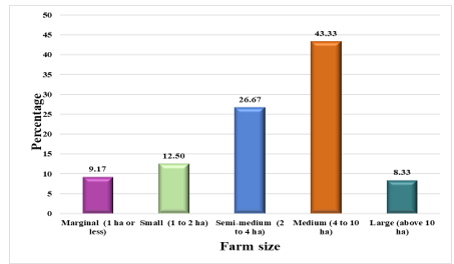
Farming experience
Table 1 showed that 60.00 per cent of the respondents had medium level of farming experience followed by high (21.67%) and low (18.33%). This is likely because farming requires a balance between knowledge and risk tolerance. Medium-experience respondents have likely gained the skills and experience to be productive without being set in their ways, making them the most common group. This finding was in line with the findings of Madhu (2010).
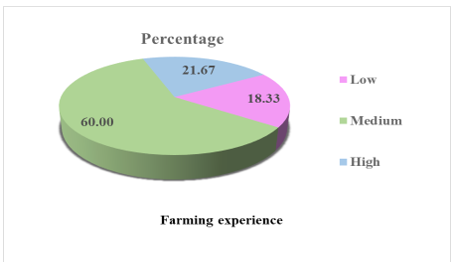
Annual income
It is noticed that 35.00 per cent of the respondents belonged to medium annual income category followed by high (34.17%) and low (30.83%) annual income categories respectively. Majority of the respondents belonged to middle income category because of limited access to both very large farms and the risks associated with high-value crops. This finding was in agreement with the findings of Atar (2012).
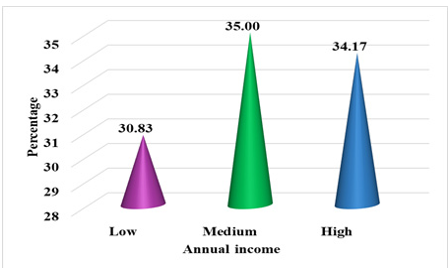
Decision making ability
A peek at the table 1 revealed that majority (74.17%) of the respondents had medium level of decision making ability followed by high (15.00%) and low (10.83%) levels of decision making ability. Factors like education, access to information etc majority of the respondents have medium decision making ability and some other have high and low decision making ability. This finding was in consistent with the findings of Naidu (2012).
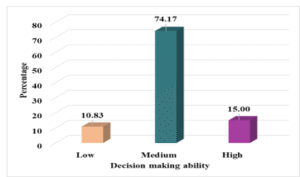
Extension contact
A desultory look at the results disclosed that majority (60.83%) of the respondents had medium level of extension contact followed by high (20.83%) and low (18.34%) levels of extension contact. This is because majority of the respondents have frequent interaction with extension agents which helped them to get aware of latest crop varieties and technologies. This finding was in conformity with the findings of Bhavitha and Reddy (2024).
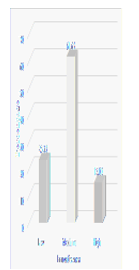
Innovativeness
The outcome conferred in the study conveyed that majority (61.67%) of the respondents were belonged to medium level of innovativeness followed by low (23.33%) and high (15.00%) levels of innovativeness. Most respondents fell into medium level of innovativeness because farming requires balancing tradition and progress. This finding confirms the findings of Vivek (2017).
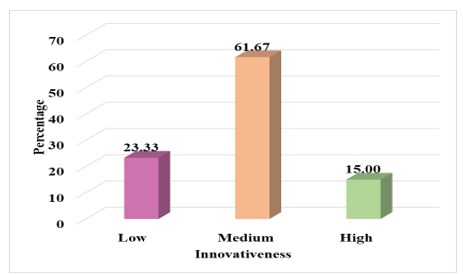
Risk orientation
It is apparent that majority (67.50%) of the respondents belonged to medium level of risk orientation category followed by low (17.50%) and high (15.00%) levels of risk orientation. Despite the inherent unpredictability of farming due to factors like weather and pests, farmers are still driven potentially expand their businesses which lead most farmers lean towards medium level of risk orientation. This finding was in conformity with the findings of Hrudayranjan (2013).
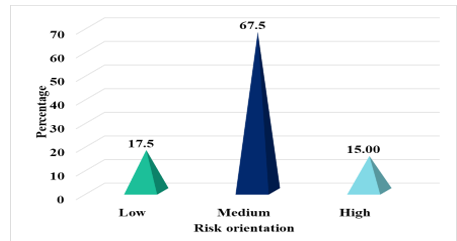
Market orientation
From the table 1 it is unravelled that nearly three-fourth (64.17%) of the respondents belonged to medium level of market orientation followed by high (19.16%) and low (16.67%) levels of market orientation. Significant number of respondents decent in the medium level of market orientation because they understand the importance of selling their crops well. This finding was in conformity with the findings of Kumar and Popat (2010).
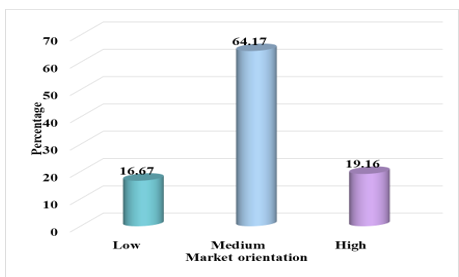
LITERATURE CITED
Areneja, C.S., Khangura, R and Rampal, V.K. 2013. Problem in adoption of pea cultivation practices faced by pea growers. Punjab Indian Journal of Social Research. 54(6): 581.
Atar, R.S. 2012. Study on knowledge and adoption of recommended grape cultivation practices by the grape growers, M.Sc. (Ag.) Thesis. Vasantrao Naik Marathwada Krishi Vidyapeeth, Parbhani, Maharashtra.
Bhavitha, G and Reddy, P. 2024. Constraints faced by farmers in supply chain management of onion in Kurnool district of Andhra Pradesh, India. Asian Journal of Agricultural Extension, Economics and Sociology. 42(3): 105-110.
Hrudayranjan, C. 2013. An exploratory study on scope and importance of farm mechanization in groundnut in Chittoor district of Andhra Pradesh. M.Sc. (Ag.) Thesis. Acharya N.G. Ranga Agricultural University, Hyderabad, India.
Kumar, S and Gupta, S. 2015. Crop diversification towards high valued crops in India: A state level empirical analysis. Agricultural Economics Research Review. 28(2): 339-350.
Kumar, G.D and Popat, M.N. 2010. Farmers’ perceptions, knowledge and management of aflatoxins in groundnuts (Arachis hypogaea L.) in India. Crop Protection. 29: 1534-1541.
Madhu, B.M. 2010. Technological gap in turmeric production practices in Belgaum district. M.Sc. (Ag.) Thesis. University of Agricultural Sciences, Dharwad, Karnataka, India.
Naidu, C.D. 2012. Study on farming performance and entrepreneurial behaviour of sugarcane farmers in North Coastal Zone of Andhra Pradesh. Ph.D Thesis. Acharya N.G. Ranga Agricultural University, Hyderabad.
Patel, C.D. 2015. A study on awareness and attitude of organic farming followers of South Gujarat. M.Sc. (Ag.) Thesis. Navsari Agricultural University, Navsari.
Patel, M.R. 2011. An impact analysis of peasantry modernization in agriculture under integrated tribal development. M.Sc. (Ag.) Thesis. Anand Agricultural University, Gujarat.
Vivek, J.K. 2017. Utilisation of Information and Communication Technologies (ICTs) by the pea growers of Patan block of Jabalpur district of Madhya Pradesh. International Journal of Current Microbiology and Applied Sciences. Jawaharlal Nehru Vishwa Vidyalaya, Jabalpur, India.